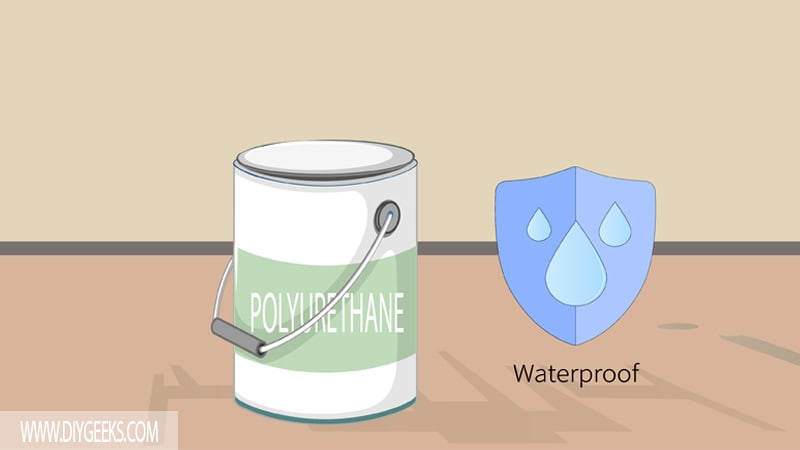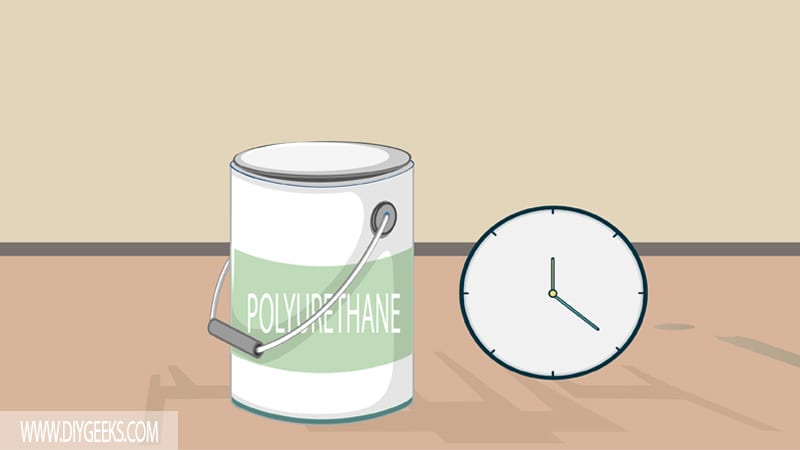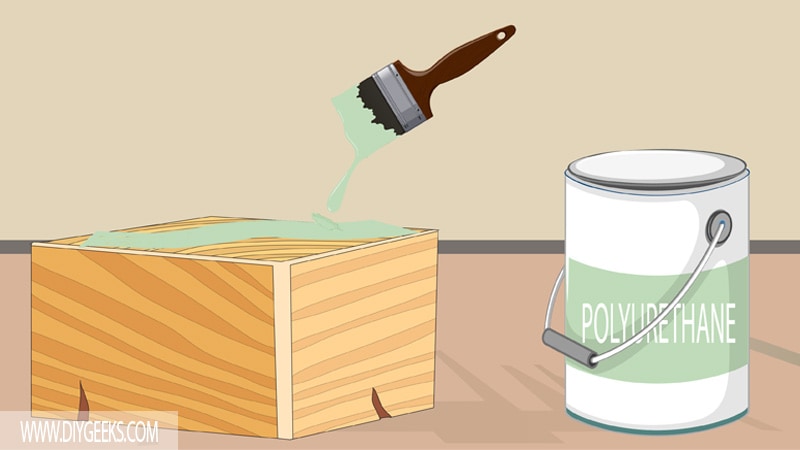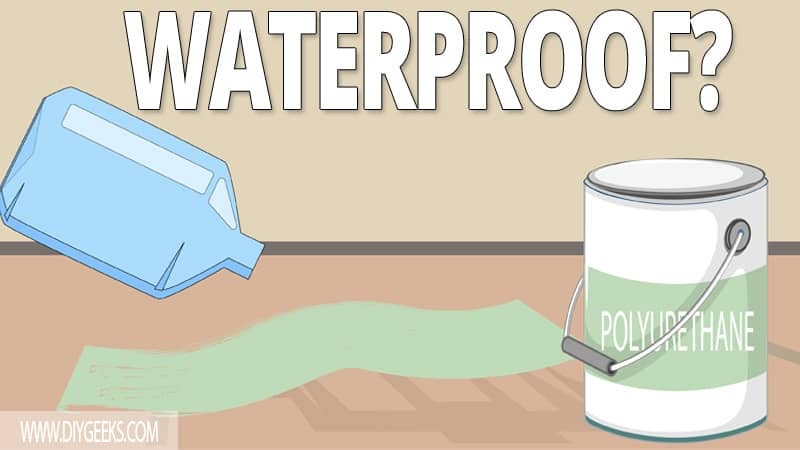Polyurethane is a durable sealer with a glossy finish. But, is polyurethane waterproof?
Polyurethane isn’t waterproof, but it has impressive water-resistance qualities. The coating will allow water to pass through 4-5 years after applying it.
Exterior polyurethane isn’t waterproof either, but its coating will withstand harsh outdoor weather for long periods of time.
Is Water-based Polyurethane Waterproof?

Water-based polyurethane isn’t waterproof but it’s water-resistant. The sealer allows moisture to gradually shift through the coating, but this takes a long time.
There is a misconception that water-based polyurethane isn’t water-resistant because it’s dissolved in water — but it’s false. Water-based polyurethane is as water-resistant as oil-based polyurethane.
The solvent (or thinner) doesn’t determine whether a finish is waterproof or not, the paint additives do. Both water-based and oil-based polyurethane have the same additives — a combination of polyol (resin) and isocyanates or diisocyanates (hardeners).
The combination of these compounds creates a tough and thick plastic film known as polyurethane. The solvent either oil or water-based is just the vehicle or carrier of the sealer.
For water-based polyurethane, water keeps the paint particles from binding in the container. For oil-based polyurethane, synthetic or natural oil keeps paint keeps the paint particles from binding together.
What Makes Polyurethane Water-Resistant?
The plastic compound and the combination of the additives (and particles) make polyurethane water-resistant.
The combination creates a thick plastic layer that has the same features as a plastic material. The layer isn’t easily dented and water will not pass through, at least for the first few years.
Polyurethane is often referred to as a plastic in a can — the reaction of the polyol resin and the hardener creates a thick plastic film that cures over time. When the sealer cures, it creates a hard plastic-like finish that prevents water from passing through.
Polyurethane has a glossy top layer that repels water. Since the top layer is glossy and slick, water will slide off the surface. This glossy layer makes the sealer resistant to oils and grease — they will slide off the coating.
Polyurethane has a flexible nature as it contracts and expands based on temperature changes. Its coating shrinks to pack the particles together when the temperature is cold or moist — this makes it hard for moisture to pass through.
How To Make Polyurethane More Water-Resistant?
To make polyurethane more water-resistant do the following things.
- Apply a Polish.
- Speed up the Polymerization.
- Apply a Sealer.
1. Apply a Polish
A polish compound will make polyurethane more water-resistant. Linseed oil or other polishing products will prevent water from getting to the sealer.
The water must go through two coats of polish before getting to the polyurethane coating. Then, it must go through 3 coats of sealer before getting to the undercoat of material underneath.
2. Speed up the Polymerization
Polyurethane becomes water-resistant once its coating cures — this happens through the polymerization of the particles.
To speed up the polymerization or the curing process of polyurethane, increase the air circulation or heat around the coating. This will accelerate the evaporation and polymerization rate.
Note: Don’t do this for more than 5 minutes. If a coating dries too fast, the particles won’t have enough time to harden naturally and won’t be as durable.
3. Apply a Sealer
Polyurethane is durable enough without a sealer, but adding another sealer over it will improve the water resistance of the finish. You can apply exterior lacquer or varnish over it.
However, applying too many coats over a material will make the finish too thick.
Related Read: Can You Apply Gel Stain Over Polyurethane?
How Long Does Polyurethane Take To Dry To Become Water-resistant?

Water-based polyurethane must fully dry (cure) for 24 hours to become water-resistant, while oil-based polyurethane needs to fully dry (cure) for 48 hours.
The type, the number of coats, environmental conditions, and the application method all determine how long it will take before being water-resistant.
The polyurethane starts to dry immediately after it has been applied to the surface. After about 2-4 hours, the sealer becomes dry to touch without being sticky. In this state, the coating is nowhere near water-resistant.
After about 24 hours, the solvent (oil or water) evaporates completely. This is when the curing process begins. However, at this stage, the coating still isn’t water-resistant.
When polyurethane cures, the reaction between the hardener and resin is completed. The particles have become tightly packed, hard, and impermeable. After it cures, the sealer will produce a top glossy layer. All these features combined make the polyurethane water-resistant.
The sealer will take longer to dry if you apply more than 3 coats as you must wait for each coat to dry before applying the next one. The sealer will take longer to dry and turn sticky if you apply it in moist conditions or on a filthy surface.
Does Polyurethane Become Less Water-Resistant Over Time?
Polyurethane does become less water-resistant over time as its coating starts to wear off. The contraction and expansion of the coating will cause it to stretch and develop hairline splits. Water will get inside the coating from the scratches.
A polyurethane finish will degrade as you walk on or place heavy objects over it. The gradual degradation of the polymer from usage causes it to become less water-resistant.
It takes polyurethane 4-5 years to become less water-resistant.
Does Polyurethane Waterproof Wood?

Polyurethane doesn’t make wood waterproof as it produces a water-resistant coating only, and covers only one side of the wood, so water can still get through the other sides.
The side of the wood covered by polyurethane will be shielded from spills, drips, and moisture. It will prevent water from getting underneath the wood, which reduces the absorption of moisture by the wood.
You must apply multiple coats of the sealer to make it water-resistant — one coating isn’t strong enough and will easily scratch and dent. Once the sealer dents, the moisture resistance will be reduced as water will penetrate the surface through the dents.
You need at least 3 coats to make a surface water-resistant.
Is Exterior Polyurethane Waterproof?
Exterior polyurethane isn’t waterproof, but its water-resistant qualities are impressive.
It has better water-resistant qualities than all other polyurethanes as it’s specially formulated with resins and additives to make it thrive in outdoor weather, including heavy rainfall.
Exterior polyurethane is specially made for outdoor surfaces, so its coating is designed to be watertight and is formulated with UV-blocking additives.


